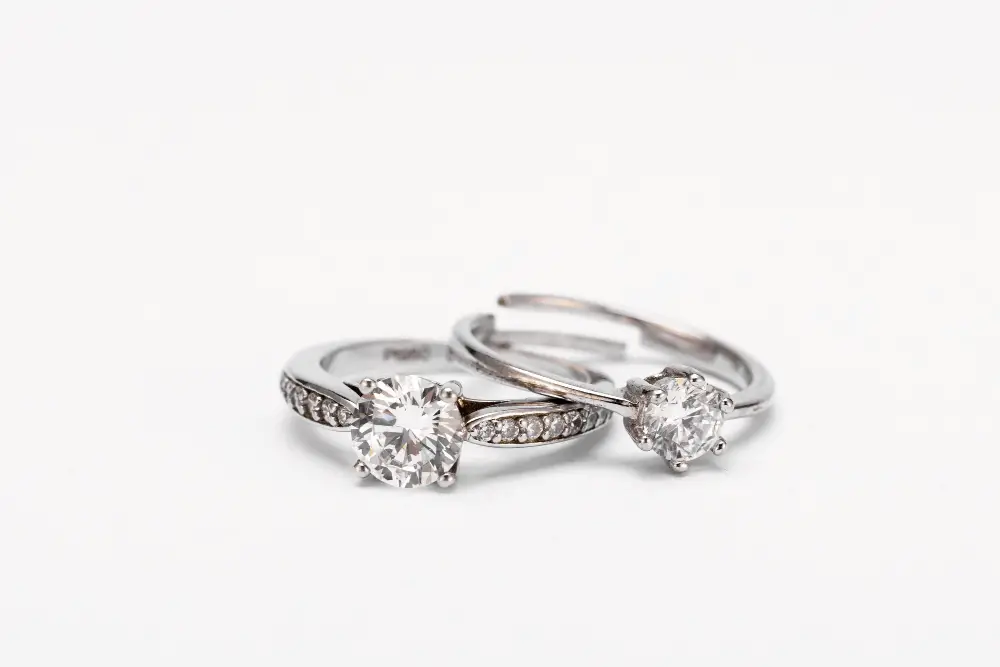Yellow gold is pure gold mixed with alloys, retaining its natural color, while white gold is created by mixing pure gold with white metals like nickel or palladium to achieve a silver-white appearance.
What is gold?
Gold, the mesmerizing metal that has been revered throughout history, is a chemical element with the symbol Au (derived from the Latin word “aurum“). It is one of the most precious and sought-after metals in the world. What sets gold apart from other elements is its remarkable properties – it is dense, malleable, and resistant to corrosion. These characteristics make it perfect for crafting intricate jewelry pieces that stand the test of time.
Yellow gold

Yellow gold is a classic and timeless choice for jewelry enthusiasts. It has been revered for centuries due to its warm, rich hue that symbolizes luxury and opulence. Yellow gold is created by combining pure gold with alloy metals such as copper and zinc, which give it its distinctive color.
One of the main benefits of yellow gold is its durability. The alloy metals used in its composition make it stronger and more resistant to scratches than pure gold. This makes yellow gold an excellent choice for everyday wear jewelry like rings or bracelets.
White gold

White gold is a popular choice for jewelry enthusiasts looking for an elegant and modern alternative to traditional yellow gold. White gold is a pure gold mixed with other alloys, white gold is created by combining pure gold with white metals such as palladium or silver. This mixture gives the metal a silvery-white appearance that resembles platinum.
One of the distinct characteristics of white gold is its versatility. It can be easily molded into intricate designs and set with various gemstones to create stunning pieces of jewelry. Additionally, white gold tends to enhance the brilliance of diamonds and other precious stones, making them appear even more dazzling.
Yellow gold Vs. White gold – Key differences
| Yellow Gold | White Gold | |
|---|---|---|
| Color | Natural yellow | Silver-white |
| Composition | Pure gold mixed with alloys (such as copper) | Pure gold mixed with white metals (e.g., nickel, palladium) |
| Appearance | Warm and traditional | Modern and contemporary |
| Maintenance | May require less maintenance and rhodium plating | May require periodic rhodium plating |
| Suitability | Complements warmer skin tones | Suits a wide range of skin tones |
| Allergies | Rarely causes allergic reactions | Potential for allergic reactions to white metal alloys |
| Availability | Widely available | Readily available |
| Popularity | Longstanding popularity | Increasing popularity in recent years |
| Price | Price varies based on purity and craftsmanship | Price varies based on purity and craftsmanship |
The different types of gold
Yellow Gold: This is the natural color of gold, achieved by mixing pure gold with alloy metals such as copper or silver.
White Gold: Created by mixing pure gold with white metals like nickel, palladium, or silver, white gold has a silver-white appearance. It is often plated with rhodium to enhance its brightness.
Rose Gold: Also known as pink or red gold, rose gold is created by adding copper to pure gold. The resulting alloy has a warm, reddish hue.
Green Gold: Green gold is made by adding silver to pure gold. It has a greenish tint and is not as common as other gold alloys.
Blue Gold: Blue gold is a result of mixing gold with metals like iron or gallium. It has a bluish tone and is mainly used in specialized applications.
Black Gold: Black gold is created by applying a surface treatment, such as oxidation or coating, to yellow or white gold, resulting in a black appearance.
How to care for gold jewelry
- Avoid harsh chemicals: Remove your gold jewelry before using household cleaning agents, chemicals, or swimming in chlorinated water, as they can damage the metal.
- Keep away from lotions and cosmetics: Apply lotions, perfumes, and cosmetics before putting on your gold jewelry to prevent buildup or discoloration.
- Store properly: Store gold jewelry in a clean, dry place, preferably in separate compartments or soft pouches to prevent scratches or tangling.
- Clean regularly: Gently clean your gold jewelry using a mild soap or specialized gold jewelry cleaner. Use a soft brush or cloth to remove any dirt or residue. Avoid using abrasive materials that can scratch the surface.
- Polish gently: To restore shine, use a jewelry polishing cloth designed specifically for gold. Avoid excessive rubbing, as it can wear away any gold plating.
- Remove during physical activities: Take off your gold jewelry before engaging in activities that may cause physical impact or damage, such as sports, heavy lifting, or gardening.
- Check prongs and settings: Regularly inspect prongs and settings to ensure stones are secure. Loose settings can lead to stone loss or damage.
- Professional maintenance: Periodically take your gold jewelry to a professional jeweler for inspection, cleaning, and any necessary repairs.
What is gold plating?
Gold plating is a popular technique used to enhance the appearance of various objects and jewelry. It involves depositing a thin layer of gold onto the surface of another metal, such as silver or copper. The process typically starts with cleaning and preparing the base metal, followed by immersing it in an electroplating solution containing gold ions.
What is electroplating?
During electroplating, an electric current is passed through the solution, causing the gold ions to attach themselves to the object’s surface. This creates a beautiful finish that mimics solid gold but at a more affordable price point.
Advantages of gold plating
One advantage of gold plating is its versatility – it can be applied to almost any material, including metals like stainless steel or even plastic. Additionally, it allows for greater customization options since different shades and thicknesses of gold can be used.
However, it’s important to note that gold-plated items are not as durable as solid gold pieces. Over time, the thin layer of plated gold may wear off due to factors like friction or exposure to chemicals. Therefore, proper care should be taken when wearing or cleaning these items.
What is the difference between 18k gold and 9k gold?
Gold Content: 18k gold contains 75% pure gold (or 18 parts out of 24), while 9k gold contains 37.5% pure gold (or 9 parts out of 24). Therefore, 18k gold has a higher gold content and is considered more valuable than 9k gold.
Alloy Composition: To make the gold more durable and suitable for jewelry, both 18k and 9k gold are mixed with other metals, known as alloys. However, the specific alloys used differ. 18k gold commonly includes metals like copper, silver, or palladium, while 9k gold often contains a higher proportion of other metals like copper, zinc, or nickel.
Color and Appearance: Due to differences in alloy composition, 18k gold typically has a richer, warmer yellow color compared to 9k gold, which may have a slightly paler or lighter yellow hue.
Durability and Hardness: 9k gold is generally considered harder and more durable than 18k gold due to the higher proportion of other metals in its composition. This can make 9k gold less prone to scratches or damage.
Price: The higher gold content and value of 18k gold usually make it more expensive than 9k gold, which contains a lower percentage of pure gold.
What is the difference between Karats and Carats?
In the context of gold, karat is a unit used to measure its purity. It tells you how much of the metal is pure gold versus other metals like copper or silver that are mixed in to make it stronger and more durable. So when you see 24k gold, it means that it is 100% pure gold.
Carat refers to the weight of gemstones such as diamonds. It measures how much a stone weighs and helps determine its value. One carat is equal to 200 milligrams or 0.2 grams.
Image Credits
Featured Image By – Steve Bidmead from Pixabay
Image 1 By – Arek Socha from Pixabay
Image 2 By – wirestock on Freepik








